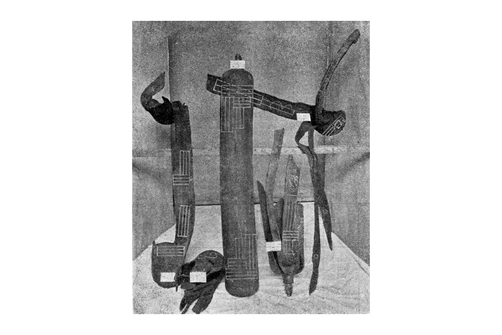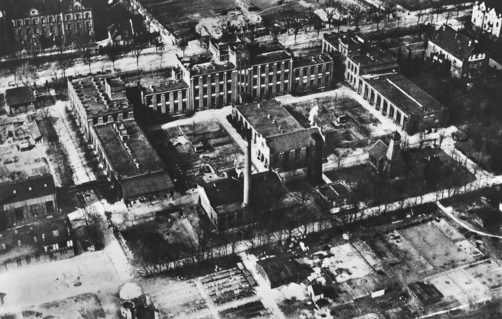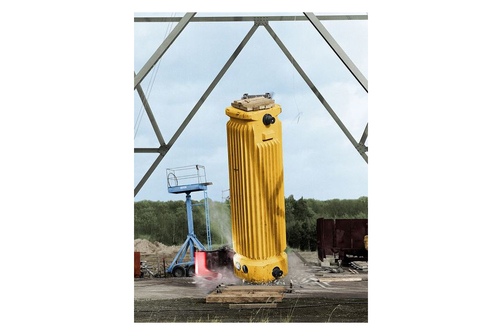BAM looks back on a long history and tradition. This ranges from the first materials strength tests in the public interest, across various mergers of institutions and agencies to the continuous research for new technologies and methods of today.
Please explore more about the diverse predecessor institutions that have been incorporated into today's BAM, and about the exciting tasks that challenge our staff every day.
We will present some notable BAM projects from recent decades. Whether it involves the failure assessment of the Berlin Liberty Bell, the testing of nuclear waste transport containers, an expert report on the Hitler diaries or the development of measurement methods for car exhaust – all of these cases were of particular public interest, often with far-reaching implications.
further information
-
The beginnings of systematic failure analysis (1871 - 1894)
1871: The Founding of the Organisation
The Preußische Königliche Mechanisch-Technische Versuchsanstalt (Prussian Royal Laboratory for Mechanical Testing) within the Königliche Technische Hochschule (Royal Technical University) in Berlin was the predecessor of today's Federal Institute for Materials Research and Testing (BAM). The organisation’s mission was to conduct mechanical tests of materials and other tests that were of general scientific and public interest.
1880: Adolf Martens’ Microscope
In collaboration with the Franz Schmidt & Haensch, Berlin and Carl Zeiss, Jena companies, Adolf Martens developed a metallographic microscope, which enabled him to study the microstructure of grey cast iron and steel with precision.

Portrait of Adolf Martens and the graphic of a microscope
Source: BAM
1889: Testing of Explosives
The Prussian War Ministry founded the Zentralversuchsstelle für Explosivstoffe (Central Testing Office for Explosives) in 1889 to advise the Prussian army on all chemical and physical questions about cartridge and explosives technology. The institute was renamed Versuchsstelle für Sprengstoffe (Testing Office for Explosives) in 1896 and Militärversuchsamt (Military Testing Office) in 1897.
1894: Hydrogen Explosion and the Beginning of the Modern Failure Analysis
About 70 compressed gas cylinders filled with hydrogen exploded on the 25 May 1894 on the Berlin Tempelhof landing area for airships. Heavy fragments were found within a 1500 metre radius. The Prussian military commissioned the Royal Prussian Mechanical and Materials Testing Institute headed by Adolf Martens to determine the cause of damage. This marked the beginning of systematic failure analysis, as it is currently carried out at BAM.

Hydrogen Explosion and the beginnings of modern damage analysis
Source: BAM
-
Founding of the Royal Materials Testing Office by Adolf Martens (1904 - 1936)
1904: The Merger of the Testing Offices
The Königliche Materialprüfungsamt (Royal Institute for Materials Testing), headed by Adolf Martens was established in Berlin Dahlem at the current location at Unter den Eichen by uniting the Preußischen Versuchsanstalten MTV (Prussian testing stations), Königliche Prüfungsstation für Baumaterialien (Royal Testing Station for Building Materials) and Königlich Chemisch-Technischen Versuchsanstalt (Royal Chemical Technical Testing Office). From 1919, the newly named State Materials Testing Office (MPA) was responsible to the Prussian Ministry of Science, Art and National Education.

Source: BAM
1920: Chemisch-Technische Reichsanstalt
The Chemisch-Technische Reichsanstalt (State Chemical Technical Institute) was created in 1920 after the end of World War I from the Military Testing Office and was subordinated to the Reichsministerium des Innern (Interior Ministry).

Buildings of the Chemical-technical State Institute (1904)
Source: BAM
1936: Reichsröntgenstelle
The Reichsröntgenstelle (Reich X-ray Station) was attached to State Materials Testing Office (MPA). This was the starting point of the development of non-destructive testing methods using X-ray technology at MPA and the German Society for Non-Destructive Testing (DGZfP). Industrialisation created an increasing number of steel structures where material failure could be visualised by means of X-ray methods.

X-ray inspection of a steel bridge
Source: BAM
-
Merger with the State Chemical Technical Institute (1954 - 1978)
1954: Federal Institute for Mechanical and Chemical Materials Testing
The State Materials Testing Office and the State Chemical Technical Institute were merged to form the Federal Institute for Mechanical and Chemical Materials Testing in 1954 (BAM, Federal Institute for Materials Testing since 1956) and subordinated to the Federal Ministry of Economics. BAM was increasingly charged with the execution of official materials tests for the State of Berlin.

Source: BAM
1966: Damage analysis on the Berlin Liberty Bell
A bolt of the Berlin Liberty Bell sheared in August 1966 and the clapper fell five metres to the floor below. Fortunately, no one was hurt. Due to the great public interest, BAM was commissioned with the analysis of the cause.
1969: Testing New Year’s Eve fireworks
Through the Explosives Act (25 August 1969), BAM became a senior federal authority and has tested pyrotechnics from then on.
1978: Testing nuclear waste transport containers
Since 1978, BAM has been checking the safety of nuclear waste transport containers using drop tests. At the time of the Berlin Wall, BAM operated a drop test site at Lehre-Kampstüh next to Brunswick.

Test site Lehre-Kampstüh: After the drop test and during the fire test...
Source: BAM

...and testing of nuclear waste transport containers
Source: BAM
Today, BAM has a drop test site on its Technical Safety Testing Site (TTS) at Horstwalde, Brandenburg that is unique in the world.
-
Notable expert reports and measurement methods (1980 - 1987)
1980: Damage analysis for the Berlin Congress Hall roof collapse
The roof of the Berlin Congress Hall collapsed on 21 May 1980. The Berlin chief prosecutor commissioned BAM to assess the damage. BAM experts found that there were several individual causes of the collapse and their simultaneous occurrence led to the catastrophe. The building was reopened on 9 May 1987 to celebrate the City of Berlin’s 750th anniversary and is currently known as the House of World Cultures.

1980 Berlin Congress Hall - BAM analysis the damages after the roof collapse
Source: BAM
1983: An expert report on the Hitler Diaries
The affair of the alleged Hitler Diaries is considered one of the biggest scandals in the history of the federal German press. In 1983, the "Stern" news magazine published the diaries counterfeited by Konrad Kujau, without awaiting the outcome of the authentication from BAM. BAM found that the paper contained UV brighteners and that the books were bound with plastic threads, a technique used only after World War Two.
1987: Developing a measurement method for car exhausts using the λ sensor
With the introduction of the lambda sensor, BAM developed a measurement method for testing car exhausts.
1987: Bundesanstalt für Materialforschung und -prüfung (Federal Institute for Materials Research and Testing)
Changing the name to Bundesanstalt für Materialforschung und -prüfung (Federal Institute for Materials Research and Testing, BAM)
-
Integration of GDR institutions and further expert reports (1990 - 1994)
1990: Integration of GDR institutions
After the German reunification, BAM’s function as chemical and technical federal institute was strengthened in accordance with the recommendation of the Board of Science. For this, the chemistry and glass departments of the dissolved Agency for Standardisation, Metrology and Product Testing (ASMW) and the dissolved GDR Academy of Sciences were integrated. The official materials testing tasks for the State of Berlin were gradually phased out by BAM.
1993: An expert report on the IKEA Billy shelves
In 1993, buyers of the IKEA Billy shelves complained of burning eyes, coughs and itching. The reason was that the chipboard released carcinogenic formaldehyde fumes. “Stern” magazine published the topic and BAM produced an expert report.
1994: Flame testing the Wrapped Reichstag
BAM tested the substance used to wrap the Reichstag – a project of Christo and Jeanne-Claude. The material must not be flammable under any circumstances in order to prevent the building from being damaged in an accident. BAM’s report also specified the duration of the wrapping, which depended on the decreasing strength of the fabric due to UV radiation.

Flame test Wrapped Reichstag
Source: BAM
-
Further examples of highly significant failure analysis (2000 - 2015)
2000: Damage analysis of MS Estonia
In 2000, BAM conducted the damage analysis of the Baltic ferry MS ESTONIA which sank in 1994. The samples of the front hatch had been under the sea for six years and were no longer usable. Therefore, BAM experts conducted comparative tests and came to the conclusion that the deformation of the material resulted not from a suspected explosion, but from the usual pre-treatment of the sheet surfaces for painting.
2006: An expert report on collapsed high-voltage pylons in Münsterland
In November 2005, ice and snow loads flattened dozens of high-voltage pylons in Münsterland. 250,000 people were left without electricity, some of them for up to 50 hours. BAM issued a report on the damaged pylons. The results showed that a chain of factors caused the failure –in addition to severe weather impacts, material weakness also played a role.
2009: Failure analysis on the derailment of the ICE 518 in Cologne
One of the 32 wheel-set axles of the ICE 518 broke in the narrow exit curve of Cologne Central Station in June 2008. The train was brought to a halt by the automatic emergency brake. BAM investigated the cause of the accident and found fatigue cracks in the material. As a result, the supervising authority – the Federal Railway Authority (EBA) – shortened the ultrasonic inspection intervals for all ICE 3 wheel-set axles from 300,000 to 60,000 km, and in some cases even 30,000 km mileages.
2015: Transport ban for CASTOR containers
BAM tested CASTORs and detected quality defects on the lifting pins. These stainless steel lifting pins serve as transportation hooks and had to be checked for irregularities via ultrasound. 315 out of the roughly 1100 containers already loaded and stored had to have their lifting pins further investigated. BAM mandated a transport ban for these CASTORs.


